Question of Week | Why is Diabetes Foot Care So Important?

Why is it important that people with diabetes pay special attention to taking care of their feet?
- Years of insulin injections can increase risk of lower extremity complications.
- People with diabetes often experience changes in lower extremity sensation and circulation.
- Unusual skin growths are associated with diabetes unless preventative measures are routinely used.
- Everyone with diabetes needs a referral to a Podiatrist to prevent foot problems from starting.
Click Here to Test your Knowledge
Want to learn more about this question?
Join us for our new FREE Webinar
3 Steps to Save Feet; Assess, Screen, and Report
Airs live July 19th at 11:30 am PST (45 to 60 minutes)
All health care professionals are invited to join us to learn strategies to protect lower extremities during this FREE Webinar.
Coach Beverly will walk participants through the 3 Step Process to Save Feet; Assess, Screen and Report. She will provide simple and clear instructions on how to assess and inspect feet, along with risk assessment and action steps. We will share free teaching tools, strategies, and documentation forms adapted from the Lower Extremity Prevention Program (LEAP) that you can immediately implement in your practice setting.
CEs: 1.0 CEs for $19 or No CEs for FREE
Topics include:
- Effective foot assessment made easy
- How to use a monofilament to assess sensation
- Using screening form to report findings
Can’t join us live?
Don’t worry, we will send you a link to the recorded version.
FREE Handouts and Resources
3 Steps to Save Feet – Assess, Screen, Report Handout. This handout walks health care professionals through the steps involved in a 10-minute foot assessment and monofilament screening. Also includes a Screening Form to document and report findings.
Foot Care Teaching Sheet – Steps to Healthy Feet. This handout covers the important elements of foot care for people living with diabetes with simple and straightforward language.
Foot Care Teaching Sheet in Spanish– Pasos Para Tener Pies Sanos. This handout covers the important elements of foot care for people living with diabetes with simple and straightforward language.

Coach Beverly Thomassian, RN, MPH, BC-ADM, CDCES
Author, Nurse, Educator, Clinician and Innovator, Beverly has specialized in diabetes management for over twenty years. As president and founder of Diabetes Educational Services, Beverly is dedicated to optimizing diabetes care and improving the lives of those with diabetes.
NEW! Order Monofilament (5.07) for Diabetes Foot Screening 20-Pack
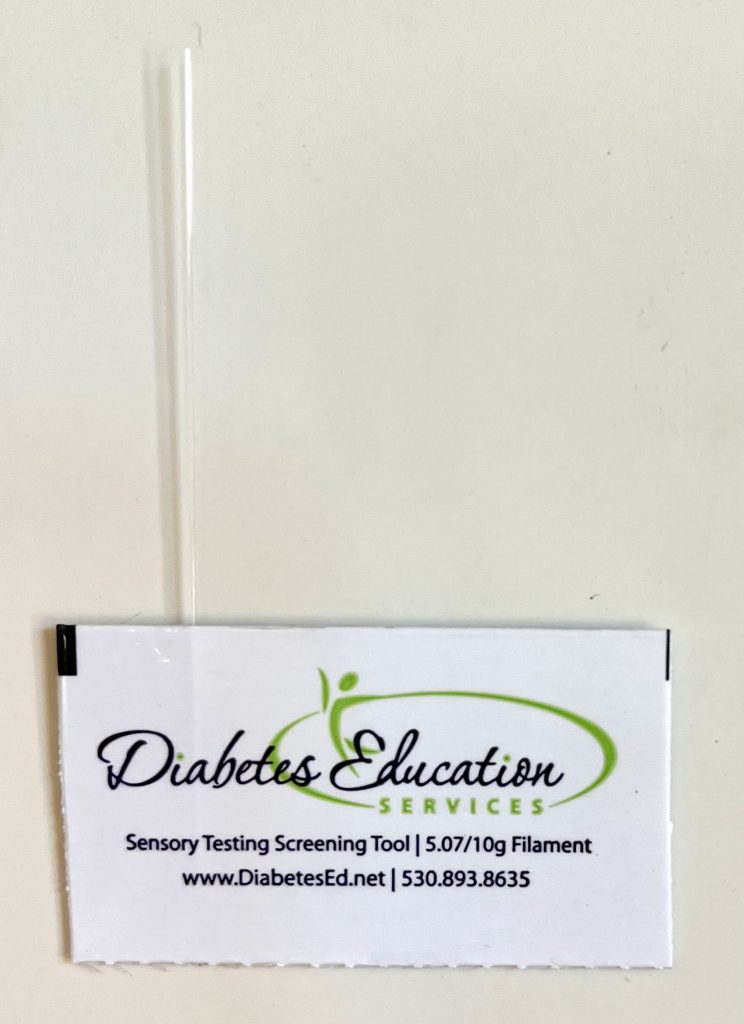
People with diabetes are at increased risk of foot complications. By using a 5.07 monofilament (delivers 10gms of linear pressure) to assess for loss of sensation, diabetes health care professionals can immediately identify high-risk feet and take steps to protect lower extremities. Basic foot care education and intervention can reduce the risk of amputation by over 50 percent.
We are excited to provide these single-use 5.07 monofilaments in packs of 20.
We have included instructions on how to assess and inspect feet, along with risk assessment and action steps. We enhanced the teaching tools and forms from the Lower Extremity Prevention Program (LEAP) and are excited to share them with our community of diabetes advocates.
Sign up for Diabetes Blog Bytes – we post one daily Blog Byte from Monday to Friday. And of course, Tuesday is our Question of the Week. It’s Informative and FREE! Sign up below!
The use of DES products does not guarantee the successful passage of the CDCES exam. CBDCE does not endorse any preparatory or review materials for the CDCES exam, except for those published by CBDCE.
July 2022 eNews | 3 Steps to”DeFeet” Amputations in People with Diabetes
July 2022 eNews | 3 Steps to”DeFeet” Amputations in People with Diabetes

Happy July
It’s officially summer. What better season to celebrate feet and lower extremities!
My passion for lower extremity advocacy began with my work at Stanford Hospital over 25 years ago. A kind-hearted man was admitted to the vascular unit with an infected foot ulcer and osteomyelitis. Despite days of antibiotic therapy and wound care, a partial foot amputation was required. He was devastated by this loss and so was I.
Here is the real tragedy. I am sure this amputation could have been prevented with some simple foot care education.
For this newsletter issue, we have put together a toolkit full of foot care resources that we are excited to share with you, including a FREE Webinar on 3 Steps to Save Feet.
Amputation rates are on the rise. We hope by sharing these tools and information, we reverse this trend and save limbs.
The great thing about foot care education is that all health care professionals can engage in sharing the prevention strategies outlined in our free handouts. Just think of all the unnecessary suffering we can prevent by looking at feet, providing education, and taking action on any unusual foot findings.
I think our foot care motto from Stanford Hospital says it best, “Lift the Sheets and Look at the Feets”. Let’s just start with this first step.
We are also overjoyed to announce that we are providing two Flower Scholarships that cover the cost of our Fall Virtual DiabetesEd Course. Applications are now being accepted.
Thank you in advance for your actions and advocacy on behalf of people living with diabetes.
Beverly, Bryanna, Robert, and Amanda
Featured Articles
- FREE Feet Toolkit
- Diabetes Wellness Visits Reduce Amputations
- 3 Steps to Save Feet FREE Webinar| July 19th
- Virtual Conference Scholarships
- Question of the Week
- Rationale of Week
Upcoming FREE Webinars
- Virtual DiabetesEd Specialist Conference|Oct. 12-14th
- CDCES Exam Prep | July 12th
- BC-ADM Exam Prep | July 14
- 3 Steps to Save Feet FREE Webinar| July 19th
Want to learn more about this question?
Join us for our new FREE Webinar
3 Steps to Save Feet; Assess, Screen, and Report
Airs live July 19th at 11:30 am PST (45 to 60 minutes)
All health care professionals are invited to join us to learn strategies to protect lower extremities during this FREE Webinar.
Coach Beverly will walk participants through the 3 Step Process to Save Feet; Assess, Screen and Report. She will provide simple and clear instructions on how to assess and inspect feet, along with risk assessment and action steps. We will share free teaching tools, strategies, and documentation forms adapted from the Lower Extremity Prevention Program (LEAP) that you can immediately implement in your practice setting.
CEs: 1.0 CEs for $19 or No CEs for FREE
Topics include:
- Effective foot assessment made easy
- How to use a monofilament to assess sensation
- Using screening form to report findings
Can’t join us live?
Don’t worry, we will send you a link to the recorded version.
FREE Handouts and Resources
3 Steps to Save Feet – Assess, Screen, Report Handout. This handout walks health care professionals through the steps involved in a 10-minute foot assessment and monofilament screening. Also includes a Screening Form to document and report findings.
Foot Care Teaching Sheet: This handout covers the important elements of foot care for people living with diabetes with simple and straightforward language.

Coach Beverly Thomassian, RN, MPH, BC-ADM, CDCES
Author, Nurse, Educator, Clinician and Innovator, Beverly has specialized in diabetes management for over twenty years. As president and founder of Diabetes Educational Services, Beverly is dedicated to optimizing diabetes care and improving the lives of those with diabetes.
NEW! Order Monofilament (5.07) for Diabetes Foot Screening 20-Pack

People with diabetes are at increased risk of foot complications. By using a 5.07 monofilament (delivers 10gms of linear pressure) to assess for loss of sensation, diabetes health care professionals can immediately identify high-risk feet and take steps to protect lower extremities. Basic foot care education and intervention can reduce the risk of amputation by over 50 percent.
We are excited to provide these single-use 5.07 monofilaments in packs of 20.
We have included instructions on how to assess and inspect feet, along with risk assessment and action steps. We enhanced the teaching tools and forms from the Lower Extremity Prevention Program (LEAP) and are excited to share them with our community of diabetes advocates.
Sign up for Diabetes Blog Bytes – we post one daily Blog Byte from Monday to Friday. And of course, Tuesday is our Question of the Week. It’s Informative and FREE! Sign up below!
The use of DES products does not guarantee the successful passage of the CDCES exam. CBDCE does not endorse any preparatory or review materials for the CDCES exam, except for those published by CBDCE.
Rationale of the Week | Best advice on adding new med, Mounjaro

For last week’s practice question, we quizzed test takers on Mounjaro, a new medication. 82% of respondents chose the best answer. We want to share this important information, so you can pass it on to people living with diabetes and your colleagues, plus prepare for exam success!
Before we start though, if you don’t want any spoilers and haven’t tried the question yet, you can answer it below: Answer Question
Question: The FDA recently approved the new ‘twincretin” dual incretin hormone therapy called Tirzepatide (Mounjaro). The provider wants to start a person with type 2 diabetes on this new medication and asks for your consultation. The person’s current medications for type 2 diabetes include metformin, empagliflozin (Jardiance), semaglutide (Ozempic), and Pravachol. What is the best response to the provider?
Answer Choices:
- Inform provider that Tirzepatide (Mounjaro) is contraindicated in people taking SGLT-2 Inhibitors.
- Recommend stopping the semaglutide (Ozempic) before starting the Tirzepatide (Mounjaro).
- Reinforce the importance of prescribing a CGM before starting Tirzepatide (Mounjaro).
- Request provider also prescribes Glucagon rescue med in case of severe hypoglycemia.
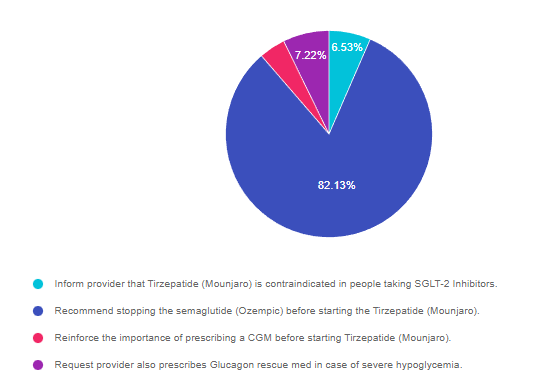
As shown above, the most common choice was option 2, the second most common answer was option 4, then option 1, and finally 3.
Getting to the Best Answer
Answer 1 is incorrect. 6.53% chose this answer, “Inform provider that Tirzepatide (Mounjaro) is contraindicated in people taking SGLT-2 Inhibitors.” According to the Package Insert, Tirzepatide can be used in combination with SGLT-2 Inhibitors and other approved diabetes medications. However, since Tirzepatide is a combination of GLP-1 and GIP Incretins, it is not recommended to use in combination with a GLP-1 RA or the DPP-IV class of medications. Read more on our blog here.
Answer 2 is correct. 82.13% of you chose this answer, “Recommend stopping the semaglutide (Ozempic) before starting the Tirzepatide (Mounjaro).” YES, GREAT JOB! Since Tirzepatide is a combination of GLP-1 and GIP Incretins, it is not recommended to use in combination with a GLP-1 RA or the DPP-IV class of medications.
Answer 3 is incorrect. 4.12% of respondents chose this answer, “Reinforce the importance of prescribing a CGM before starting Tirzepatide (Mounjaro).” Since this person is not on insulin or any medications that would cause low blood sugar, a CGM is not required to monitor blood sugars. Blood glucose monitoring combined with regular A1C testing will be important to determine the efficacy of this new “twincretin”. Read more on our blog here.
Finally, Answer 4 is incorrect. 7.22% chose this answer, “Request provider also prescribes Glucagon rescue med in case of severe hypoglycemia.” Since this person is not on insulin or any medications that would cause low blood sugar, a glucagon rescue med is not required to treat severe hypoglycemia. Blood glucose monitoring combined with regular A1C testing will be important to determine the efficacy of this new “twincretin”. Read more on our blog here.
Want to learn more about this question?
New Dual Incretin Injectable – “TwinCretin”
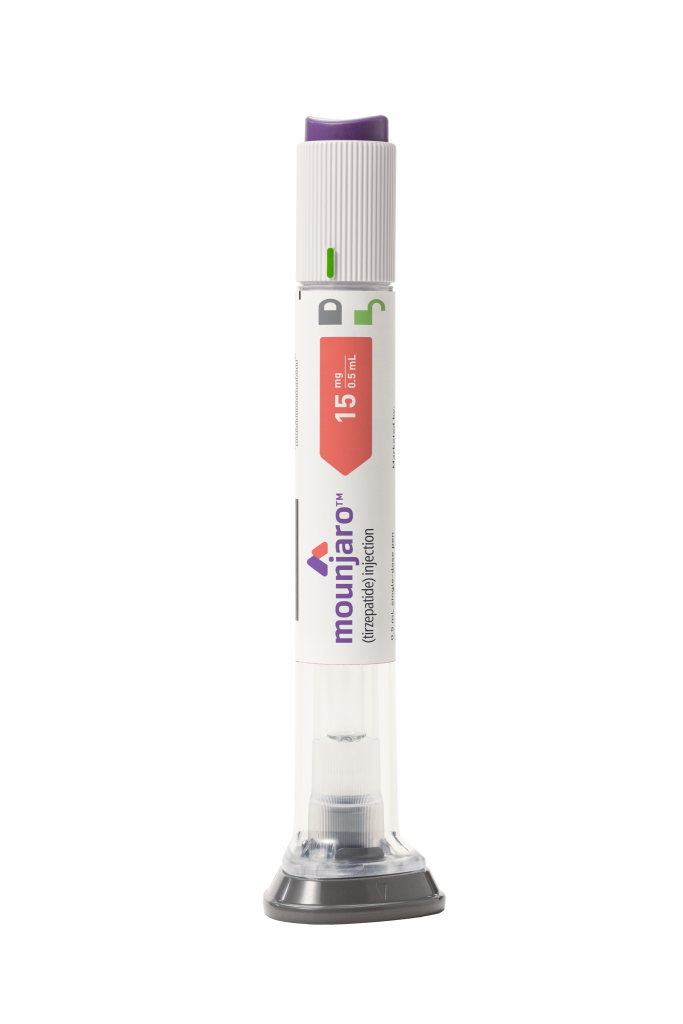
The FDA just approved a novel, dual incretin hormone therapy called Tirzepatide (Mounjaro).
This new twin incretin injectable includes not only a GLP-1 Receptor Agonist, but also a Glucose-dependent insulinotropic polypeptide (GIP), which magnifies the therapeutic effectiveness. The SURPASS studies indicate that study participants experienced an A1C drop of up to 2.5% and weight loss of up to 10kg or more.
Want to learn more about Diabetes Care? View our
Virtual DiabetesEd Specialist Conference
30+ CEs
Airs October 12-14th, 2022
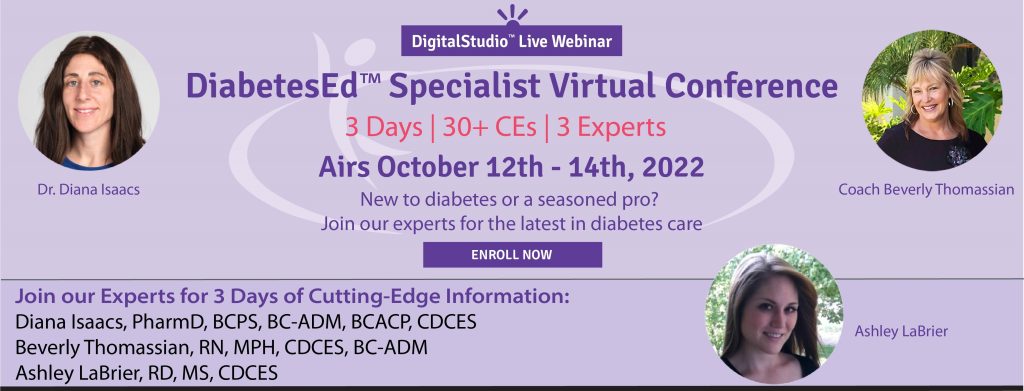
Whether you are new to diabetes or a seasoned expert, you’ll benefit from this virtual conference with the latest research plus critical content that you can immediately apply to your clinical practice.
Download Course Flyer | Download Schedule
If you are seeking a state-of-the-art review of current diabetes care, this course is for you. Our team has been fine-tuning this course for over fifteen years, and we know what you need. This program can also be a great addition to your CDCES or BC-ADM exam study plan.
Join us LIVE for this Virtual Course and enjoy a sense of community!
Team of expert faculty includes:
- Diana Isaacs, PharmD, BCPS, BC-ADM, BCACP, CDCES – Educator of the Year, 2020
- Coach Beverly Thomassian, RN, MPH, CDCES, BC-ADM
- Ashley LaBrier, MS, RD, CDCES, Diabetes Program Coordinator
Two Registration Options
Virtual DiabetesEd Specialist Conference Deluxe | 30+ CEs
Deluxe Option for $499: Virtual Program includes:
- Q & A Session with the instructor after each webinar.
- LIVE Presentations by our team of experts.
- State-of-the-art review of current diabetes care and technology.
- Resources for each session.
- Access to free podcasts and video recordings within a week of each live session for one year.
Deluxe Version includes Syllabus, Standards and Swag*:
- Diabetes Educator Course 2022 Syllabus Hard Copy – over 100 pages -This spiral-bound workbook contains the printed version of all of the instructor’s slides.
- ADA 2022 Standards of Care Book -The ADA Standards of Medical Care in Diabetes is a key resource for healthcare professionals involved in diabetes care, education, and support.
- DiabetesEd Services highlighters, Medication PocketCard, Tote Bag and Pen
Virtual DiabetesEd Specialist Conference Basic | 30+ CEs
Basic Option for $399: Virtual Program includes:
- Q & A Session with the instructor after each webinar.
- LIVE Presentations by our team of experts.
- State-of-the-art review of current diabetes care and technology.
- Resources for each session.
- Access to free podcasts and video recordings within a week of each live session for one year.
Don’t worry if you can’t make it live. Your registration guarantees access to the recorded version in the Online University.
All hours earned count toward your CDCES Accreditation Information
Sign up for Diabetes Blog Bytes – we post one daily Blog Byte from Monday to Friday. And of course, Tuesday is our Question of the Week. It’s Informative and FREE! Sign up below!
The use of DES products does not guarantee the successful passage of the CDCES exam. CBDCE does not endorse any preparatory or review materials for the CDCES exam, except for those published by CBDCE.
Rationale of the Week | Best blood sugar fix?

For last week’s practice question, we quizzed test takers on the best blood sugar fix. 64% of respondents chose the best answer. We want to share this important information, so you can pass it on to people living with diabetes and your colleagues, plus prepare for exam success!
Before we start though, if you don’t want any spoilers and haven’t tried the question yet, you can answer it below: Answer Question
Question: LS wears an insulin pump and uses lispro insulin. LS has an average basal rate of 0.6 units and hour, a 1:15 carb ratio and a 1:50 correction ratio. Based on the ambulatory glucose profile, LS is experiencing elevated glucose levels from 4am to 7am. To get glucose to target, what is the best next step?
Answer Choices:
- Add basal insulin glargine to prevent Somogyi effect
- Make sure LS isn’t consuming carbohydrates after 10pm
- Ask LS to double check their CGM insertion site
- Increase the basal rate to prevent glucose elevations
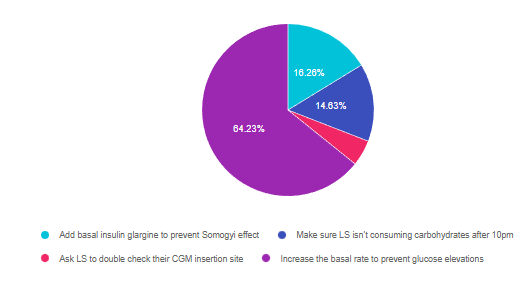
As shown above, the most common choice was option 4, the second most common answer was option 1, then option 2, and finally 3.
Getting to the Best Answer
Answer 1 is incorrect. 16.26% chose this answer, “Add basal insulin glargine to prevent Somogyi effect.” Since LS uses an insulin pump, they don’t need to inject additional basal insulin (glargine) to get overnight blood sugars to target. With an insulin pump, the bolus insulin (lispro) acts as the basal insulin, delivering background insulin at 0.6 units an hour. In addition, Simogyi is defined as rebound hyperglycemia, or the sudden increase in blood sugars, due to stress hormones, after a significant hypoglycemic event. There is no symptoms in the question that indicate that LS is experiencing a Somogyi event. This is a juicy answer, but on closer inspection, not the best one.
Answer 2 is incorrect. 14.63% of you chose this answer, “Make sure LS isn’t consuming carbohydrates after 10pm.” Based on the glucose profile, LS blood sugars are increasing around 4am, which is most likely due to the Dawn Phenomena, not late night snacking. In the middle of the night, the body starts releasing growth hormone cortisol, and catecholamines, which causes an increase in blood sugars around 4am for many people with type 1 diabetes. This is referred to as the Dawn Phenomena. The best way to manage this is to slightly increase basal rate during the period when blood sugar is on the rise.
Answer 3 is incorrect. 4.88% of respondents chose this answer, “Ask LS to double check their CGM insertion site.” While it’s always good to check to make sure devices are working properly, this isn’t the case for this question. LS is having consistent glucose elevations from 4am to 7am, which is commonly referred to as the Dawn Phenomena. In the middle of the night, the body starts releasing growth hormone cortisol, and catecholamines, which causes an increase in blood sugars around 4am for many people with type 1 diabetes. The best way to manage this is to slightly increase basal rate during the period when blood sugar is on the rise.
Finally, Answer 4 is correct. 64.23% chose this answer, “Increase the basal rate to prevent glucose elevations.” YES, GREAT JOB. LS is having consistent glucose elevations from 4am to 7am, which is commonly referred to as the Dawn Phenomena. In the middle of the night, the body starts releasing growth hormone cortisol, and catecholamines, which causes an increase in blood sugars around 4am for many people with type 1 diabetes. The best way to manage this is to slightly increase basal rate during the period when blood sugar is on the rise.
Want to learn more about this question? Join us for our upcoming webinar
Test Taking Practice Exam Toolkit | FREE Webinar
Are You Ready for Exam Success?
Join us live Thursday, June 30th at 11:30 am PST
Learn Test-Taking Secrets with Coach Bev – Option to add on 200+ Computerized Practice Test Questions for $49
During this webinar, Coach Beverly will help you transform your nervousness into focused energy that will help you succeed. She will provide test-taking tips based on her experience taking the certification exam six times.
To provide plenty of practice, Coach Beverly will sample 20 test questions that have been plucked from our Test Taking Toolkit during this live webinar.
She will explain how to dissect the question, eliminate wrong answers and avoid getting lured in by juicy answers.
Two Ways to Join
Includes a review of 20 sample test questions with test taking strategies.
This includes access to the recorded version of this webinar on your Online University Student Portal.
Plus, the Test Taking Toolkit provides you with over 200+ sample online practice questions, simulating the exam experience.
A perfect way to assess your knowledge and create a focused study plan, while increasing your test-taking confidence.
Want to learn more about Diabetes Care? View our
Virtual DiabetesEd Specialist Conference
30+ CEs
Airs October 12-14th, 2022

Whether you are new to diabetes or a seasoned expert, you’ll benefit from this virtual conference with the latest research plus critical content that you can immediately apply to your clinical practice.
Download Course Flyer | Download Schedule
If you are seeking a state-of-the-art review of current diabetes care, this course is for you. Our team has been fine-tuning this course for over fifteen years, and we know what you need. This program can also be a great addition to your CDCES or BC-ADM exam study plan.
Join us LIVE for this Virtual Course and enjoy a sense of community!
Team of expert faculty includes:
- Diana Isaacs, PharmD, BCPS, BC-ADM, BCACP, CDCES – Educator of the Year, 2020
- Coach Beverly Thomassian, RN, MPH, CDCES, BC-ADM
- Ashley LaBrier, MS, RD, CDCES, Diabetes Program Coordinator
Two Registration Options
Virtual DiabetesEd Specialist Conference Deluxe | 30+ CEs
Deluxe Option for $499: Virtual Program includes:
- Q & A Session with the instructor after each webinar.
- LIVE Presentations by our team of experts.
- State of the art review of current diabetes care and technology.
- Resources for each session.
- Access to free podcasts and video recordings within a week of each live session for one year.
Deluxe Version includes Syllabus, Standards and Swag*:
- Diabetes Educator Course 2022 Syllabus Hard Copy – over 100 pages -This spiral-bound workbook contains the printed version of all of the instructor’s slides.
- ADA 2022 Standards of Care Book -The ADA Standards of Medical Care in Diabetes is a key resource for healthcare professionals involved in diabetes care, education, and support.
- DiabetesEd Services highlighters, Medication PocketCard, Tote Bag and Pen
Virtual DiabetesEd Specialist Conference Basic | 30+ CEs
Basic Option for $399: Virtual Program includes:
- Q & A Session with the instructor after each webinar.
- LIVE Presentations by our team of experts.
- State of the art review of current diabetes care and technology.
- Resources for each session.
- Access to free podcasts and video recordings within a week of each live session for one year.
Don’t worry if you can’t make it live. Your registration guarantees access to the recorded version in the Online University.
All hours earned count toward your CDCES Accreditation Information
Sign up for Diabetes Blog Bytes – we post one daily Blog Byte from Monday to Friday. And of course, Tuesday is our Question of the Week. It’s Informative and FREE! Sign up below!
The use of DES products does not guarantee the successful passage of the CDCES exam. CBDCE does not endorse any preparatory or review materials for the CDCES exam, except for those published by CBDCE.
Question of the Week | Best advice on adding new med, Mounjaro

The FDA recently approved the new ‘twincretin” dual incretin hormone therapy called Tirzepatide (Mounjaro). The provider wants to start a person with type 2 diabetes on this new medication and asks for your consultation. The person’s current medications for type 2 diabetes include metformin, empagliflozin (Jardiance), semaglutide (Ozempic), and Pravachol. What is the best response to the provider?
- Inform provider that Tirzepatide (Mounjaro) is contraindicated in people taking SGLT-2 Inhibitors.
- Recommend stopping the semaglutide (Ozempic) before starting the Tirzepatide (Mounjaro).
- Reinforce the importance of prescribing a CGM before starting Tirzepatide (Mounjaro).
- Request provider also prescribes Glucagon rescue med in case of severe hypoglycemia.
Click Here to Test your Knowledge
Want to learn more about this question? Read our blog
New Dual Incretin Injectable – “TwinCretin”

The FDA just approved a novel, dual incretin hormone therapy called Tirzepatide (Mounjaro).
This new twin incretin injectable includes not only a GLP-1 Receptor Agonist, but also a Glucose-dependent insulinotropic polypeptide (GIP), which magnifies the therapeutic effectiveness. The SURPASS studies indicate that study participants experienced an A1C drop of up to 2.5% and weight loss of up to 10kg or more.
Enroll in our Test Taking Practice Exam Toolkit | FREE Webinar
Are You Ready for Exam Success?
Join us live Thursday, June 30th at 11:30 am PST
Learn Test-Taking Secrets with Coach Bev – Option to add on 200+ Computerized Practice Test Questions for $49
During this webinar, Coach Beverly will help you transform your nervousness into focused energy that will help you succeed. She will provide test-taking tips based on her experience taking the certification exam six times.
To provide plenty of practice, Coach Beverly will sample 20 test questions that have been plucked from our Test Taking Toolkit during this live webinar.
She will explain how to dissect the question, eliminate wrong answers and avoid getting lured in by juicy answers.
Two Ways to Join
Includes a review of 20 sample test questions with test taking strategies.
This includes access to the recorded version of this webinar on your Online University Student Portal.
Plus, the Test Taking Toolkit provides you with over 200+ sample online practice questions, simulating the exam experience.
A perfect way to assess your knowledge and create a focused study plan, while increasing your test-taking confidence.
The use of DES products does not guarantee the successful passage of the CDCES exam. CBDCE does not endorse any preparatory or review materials for the CDCES exam, except for those published by CBDCE.
FREE Self-Care Goal Sheet – Now In Spanish
We are excited to share this FREE Diabetes Self-Care Goal Sheet that you can customize for your practice.
Setting realistic person-centered goals is a critical part of providing diabetes education care and support. We have created a goal sheet that you can use in your practice to capture the next steps toward improving self-care.
You can customize this sheet with your logo and contact information or just download and print the PDF to get started. No permission is needed. We are delighted to share these sheets with you.
- Diabetes Self-Care Goal Sheet in English in Word and Diabetes Self-Care Goal Sheet in Spanish in Word so you can make modifications for your practice.
- Or you can download the PDF version of the Diabetes Self-Care Goal Sheet in English and PDF version of the Diabetes Self-Care Goal Sheet in Spanish, print and go.
Start small and Build on Success
Taking on a new behavior is not easy.
By careful coaching, we can help participants create goals that are REALLY achievable and important to the individual.
For example, someone says they want to “eat more healthfully”, then we can ask, “What would that look like for you?”. They might reply, “I want to eat for more fruits and vegetables instead of junk food”. To get more specific, we can discuss how many servings of fruit and vegetables a day do they think would be realistic? We can encourage individuals to start with one to two servings a day and gradually increase portions as the person gains more confidence in their ability.
To help build success, we may want to emphasize that is doesn’t matter whether people consume fresh, frozen or canned fruits and vegetables. They all offer similar nutrient values. The main consideration is highlighting affordable and appealing fruits and veggies based on the individuals’ taste and preferences.
This simple goal sheet can help capture the negotiated goals and follow-up care activities. This checklist of activities can also be reminders for us to discuss eye and foot care, plus oral hygiene and vaccinations too.
Self-Care Cheat Sheets in English
Self-Care Cheat Sheets in Spanish
Test Taking Practice Exam Toolkit | FREE Webinar
Are You Ready for Exam Success?
Join us live Thursday, June 30th at 11:30 am PST
Learn Test-Taking Secrets with Coach Bev – Option to add on 200+ Computerized Practice Test Questions for $49
During this webinar, Coach Beverly will help you transform your nervousness into focused energy that will help you succeed. She will provide test-taking tips based on her experience taking the certification exam six times.
To provide plenty of practice, Coach Beverly will sample 20 test questions that have been plucked from our Test Taking Toolkit during this live webinar.
She will explain how to dissect the question, eliminate wrong answers and avoid getting lured in by juicy answers.
Two Ways to Join
Includes a review of 20 sample test questions with test taking strategies.
This includes access to the recorded version of this webinar on your Online University Student Portal.
Plus, the Test Taking Toolkit provides you with over 200+ sample online practice questions, simulating the exam experience.
A perfect way to assess your knowledge and create a focused study plan, while increasing your test-taking confidence.
The use of DES products does not guarantee the successful passage of the CDCES exam. CBDCE does not endorse any preparatory or review materials for the CDCES exam, except for those published by CBDCE.
Rationale of the Week | New diabetes at 13, best next step?

For last week’s practice question, we quizzed test takers on MR who was recently diagnosed with diabetes at age 13. 70% of respondents chose the best answer. We want to share this important information, so you can pass it on to people living with diabetes and your colleagues, plus prepare for exam success!
Before we start though, if you don’t want any spoilers and haven’t tried the question yet, you can answer it below: Answer Question
Question: MR is 13 years old, and went to urgent care because they weren’t feeling well and told the Provider “I feel so tired all the time and I have to go the bathroom a lot”. The provider draws labs and gets a urine sample. The A1C is 8.7% with some ketones in the urine. The antibody results aren’t back yet. Based on the ADA Standards and this information, what is the best action?
Answer Choices:
- Start MR on basal insulin
- Order a nutrition consult ASAP and provide MR with a meter
- Initiate GLP-1 therapy to help lower glucose and A1C
- Start metformin therapy, then add exenatide XR if needed
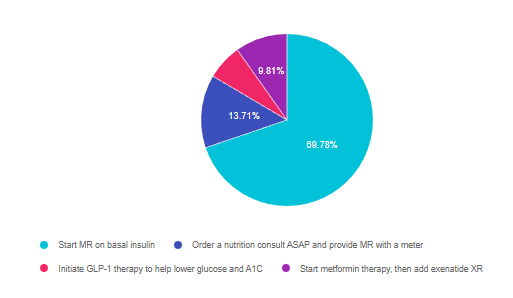
As shown above, the most common choice was option 1, the second most common answer was option 2, then option 4, and finally 3.
Getting to the Best Answer
Answer 1 is correct. 69.78% chose this answer, “Start MR on basal insulin.” YES, GREAT JOB. This is the best answer according to ADA Standard 14 on Diabetes and Youth. If a person under the age of 18 has new-onset diabetes and an A1C of 8.5% or greater, basal insulin is needed to get blood glucose to target and stop ketosis. The next step is to determine if they have immune-mediated diabetes by evaluating their autoantibodies. If they don’t have autoantibodies (GAD, ICA, IAA), then the guidelines suggest starting metformin and gradually decreasing the insulin to see if they can be managed on metformin alone or with the addition of a GLP-1 RA. If the antibodies come back positive, MR would need to be managed on basal-bolus insulin therapy.
Answer 2 is incorrect. 13.71% of you chose this answer, “Order a nutrition consult ASAP and provide MR with a meter.” This is a juicy answer since a nutrition consult and meter are critical to managing a new diabetes diagnosis. However, we would provide the nutrition consult after we figure out what type of diabetes and after lowering blood glucose levels with insulin to prevent a hyperglycemic crisis. Regardless of the type of diabetes, ordering a meter right away and providing basic nutrition guidelines are both critical steps to keep MR safe and to evaluate treatment response.
Answer 3 is incorrect. 6.70% of respondents chose this answer, “Initiate GLP-1 therapy to help lower glucose and A1C.” Since the A1C is above 8.5%, the ADA Standards state to start basal insulin to lower glucose and prevent hyperglycemic crises. If the autoantibodies come back negative, we would start metformin therapy and consider a GLP-1 RA as a future add-on therapy.
Finally, Answer 4 is incorrect. 9.81% chose this answer, “Start metformin therapy, then add exenatide XR if needed.” Since the A1C is above 8.5%, the ADA Standards state to start basal insulin to lower glucose and prevent a hyperglycemic crisis. If the autoantibodies come back negative, we would start metformin therapy and consider a GLP-1 RA as a future add-on therapy.
Want to learn more about this question? Join us for our upcoming webinar
Test Taking Practice Exam Toolkit | FREE Webinar
Are You Ready for Exam Success?
Join us live Thursday, June 30th at 11:30 am PST
Learn Test-Taking Secrets with Coach Bev – Option to add on 200+ Computerized Practice Test Questions for $49
During this webinar, Coach Beverly will help you transform your nervousness into focused energy that will help you succeed. She will provide test-taking tips based on her experience taking the certification exam six times.
To provide plenty of practice, Coach Beverly will sample 20 test questions that have been plucked from our Test Taking Toolkit during this live webinar.
She will explain how to dissect the question, eliminate wrong answers and avoid getting lured in by juicy answers.
Two Ways to Join
Includes a review of 20 sample test questions with test-taking strategies.
This includes access to the recorded version of this webinar on your Online University Student Portal.
Plus, the Test Taking Toolkit provides you with over 200+ sample online practice questions, simulating the exam experience.
A perfect way to assess your knowledge and create a focused study plan, while increasing your test-taking confidence.
From Tots to Teens | Level 2 | $29 for 1.5 CEs
Recorded & Ready to Watch!

This course includes updated goals and guidelines for children living with type 1 or type 2 diabetes. This course discusses the special issues diabetes educators need to be aware of when working with children with diabetes and their families. We discuss the clinical presentation of diabetes, goals of care, and normal growth and development through the early years through adolescence. Strategies to prevent acute and long term complications are included with an emphasis on positive coping for family and child with diabetes.
Objectives:
- Discuss the goals of care for Type 1 and Type 2 Kids with Diabetes
- State Strategies to prevent acute and chronic complications
- Discuss the importance of positive psychosocial adjustment and resources
The use of DES products does not guarantee the successful passage of the CDCES exam. CBDCE does not endorse any preparatory or review materials for the CDCES exam, except for those published by CBDCE.
Does Intermittent Fasting Really Lead to Weight Loss?
In health care settings across the country, people with diabetes and providers have been asking if intermittent fasting is effective at helping with weight loss. Finally, a randomized outpatient study provides some answers so we can accurately respond to this frequently asked question.
According to a recent study published in The New England Journal of Medicine, “a regimen of time-restricted eating was not more beneficial with regard to reduction in body weight, body fat, or metabolic risk factors than daily calorie restriction.”
In this study, 139 participants were randomized into two groups. Both groups were placed on a limited calorie diet. Men in the study were limited to a 1500 to 1800 kcal per day diet while women were limited to a 1200 to 1500 kcal per day diet.
The main difference, was the eating time frame.
The intermittent fasting group ate their calorie-restricted diet between the limited hours of 8:00 am to 4:00 pm. Which is a fasting period of 16 hours and an eating window of 8 hours.
The control group also followed the calorie restrictions but could eat their assigned calories at whatever time.
Results After One Year
After a 12-month period of following these diets, each group was evaluated for changes in body weight, body fat, waist circumference, body-mass index (BMI), and metabolic risk factors. 85% of participants completed the trial.
The participants in the time-restricted group had a mean weight loss from baseline of -8.0 kg while the calorie restriction only group had a 6.3 kg mean weight loss from baseline. While the time-restricted group had a higher weight loss, it wasn’t enough to reach statistical significance.
Additionally, there were no statistically significant changes in waist circumference, body fat, body lean mass, BMI, blood pressure, and other metabolic risk factors between the two groups.
The conclusion is that time-restricted eating was not significantly beneficial in weight loss in comparison to following a calorie-restricted diet.
To read more, click here.








